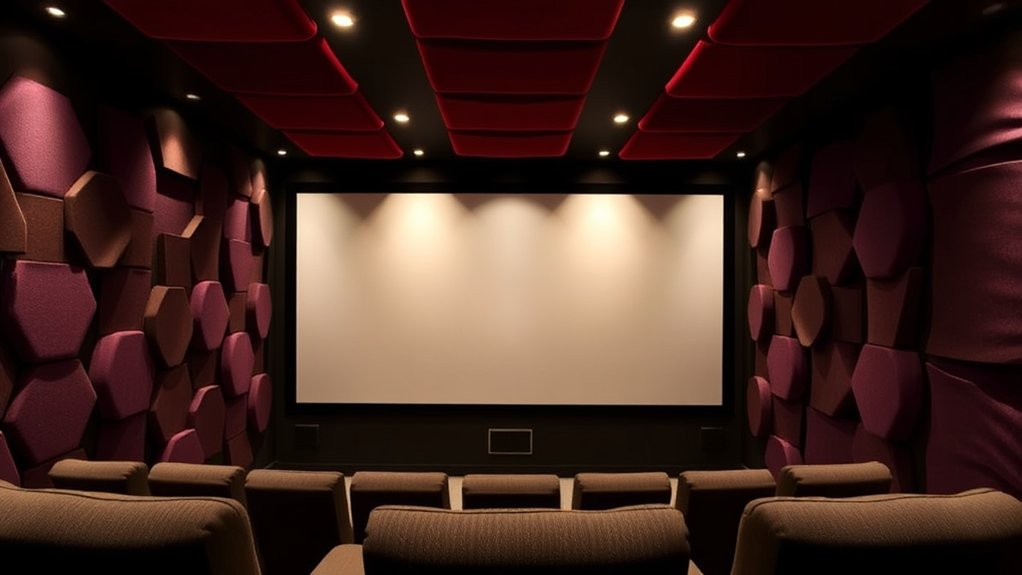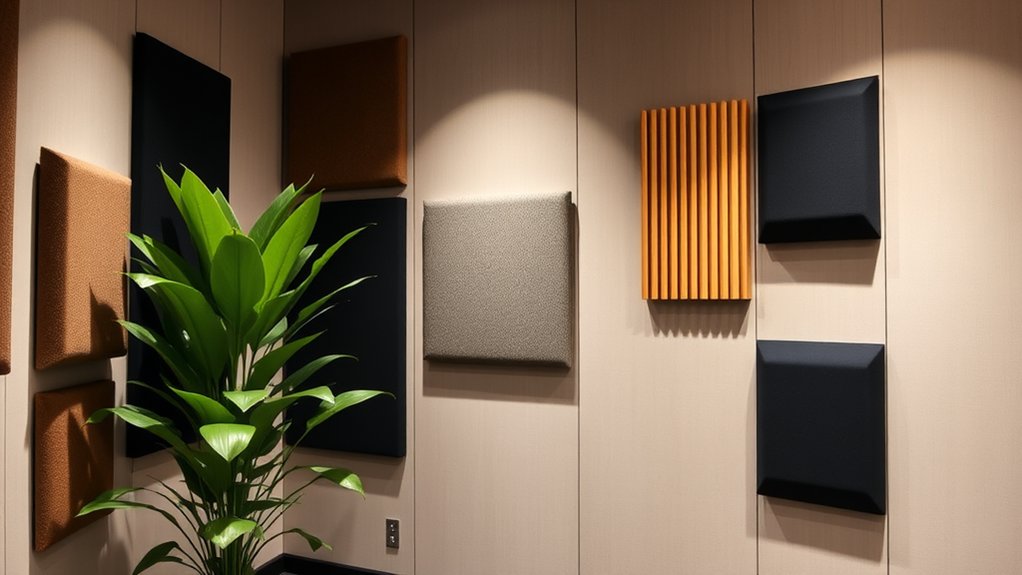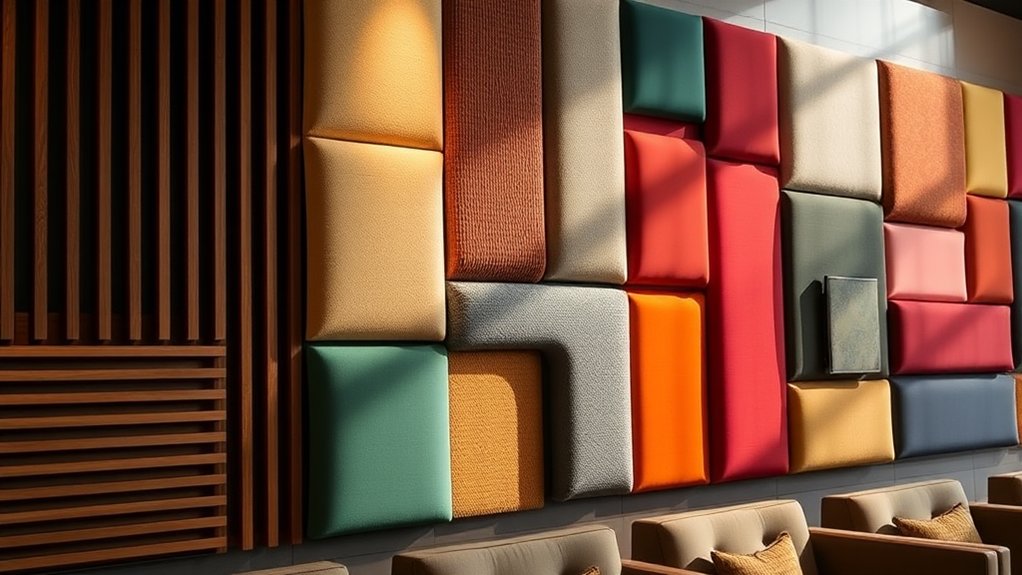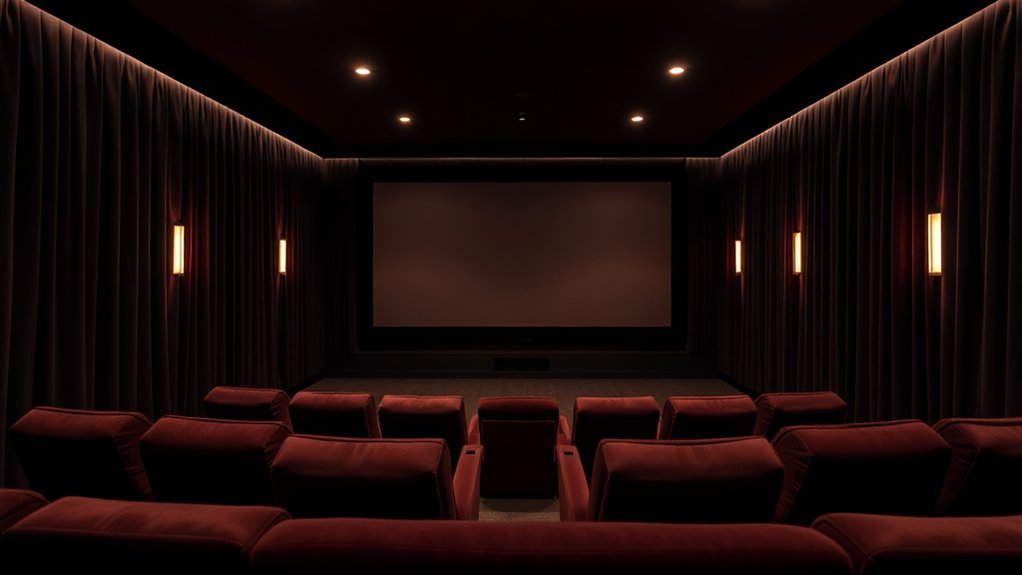In terms of optimizing acoustics, selecting the right wall panels is key. Foam panels are great for minimizing echoes, whereas fabric-wrapped ones add style and absorption. If you’re looking for charm, consider perforated wood panels or diffuser options that scatter sound waves. Bass traps are crucial for controlling those low frequencies that can muddy your audio. Want to find out which products fit your home theater best? There’s a lot more to investigate!
Key Highlights
- Foam panels effectively minimize echoes, making them ideal for lively spaces like recording studios or home theaters.
- Fabric-wrapped panels enhance aesthetics while providing excellent sound absorption, suitable for various interior designs.
- Perforated wood panels add charm and warmth, offering both sound absorption and visual appeal in residential settings.
- Bass traps are essential for controlling low frequencies, ensuring clarity in sound and preventing distortion in music or dialogue.
- Combining different types of panels, such as absorption and diffusion, creates a well-rounded acoustic environment tailored to specific needs.
Types of Acoustic Panels for Home Theaters

As far as selecting acoustic panels for your home theater, it’s a bit like selecting the perfect ingredients for a delicious recipe—each type offers its unique flavor to your sound experience. Foam panels are great for tackling echoes, whereas fabric-wrapped panels blend sound absorption with aesthetics, making your space feel cozy. Furthermore, acoustic panels are essential for enhancing the overall sound quality by reducing unwanted noise reflections. If you’re craving a touch of elegance, perforated wood panels can improve the room’s charm as they absorb sound. Additionally, high NRC ratings indicate panel effectiveness in minimizing reverberation and echoes, ensuring you achieve optimal sound quality. Conversely, diffuser panels scatter sound waves, adding an airy quality. For bass control, don’t skip on bass traps, as they tame those low frequencies that can create a raucous clutter.
Key Materials Used in Acoustic Wall Panels
The foundation of effective acoustic wall panels lies in the materials used to construct them. You’ll often find mineral wool and fiberglass wool leading the pack; mineral wool absorbs low frequencies well, but its framing can create unwanted reflections. Conversely, fiberglass panels boast a frameless design, allowing for increased absorption across a wider frequency range. Sound absorption is primarily about controlling reflections rather than complete absorption, making material selection crucial to achieving desired sound quality outcomes. If aesthetics matter to you, polyester acoustic panels offer lively options while being eco-friendly and effective, guaranteeing you don’t have to compromise style for function. And let’s not forget about the acoustic fabrics that cover these panels; they need to let sound through, like a good host at a party, making certain all guests feel welcome—and quiet! One important consideration when choosing fabrics is transparency/breathability, as this ensures that sound can pass through and be absorbed by the panel core effectively.
Performance Factors That Influence Sound Quality

When you immerse yourself in the world of sound quality, you’ll quickly reveal that several performance factors play a significant role in shaping your acoustic experience.
First, the thickness and density of acoustic panels directly impact absorption; thicker panels tend to trap lower frequencies better. Furthermore, materials with a high Noise Reduction Coefficient (NRC) absorb sound more effectively—think of it as your soundproofing superhero! Combination of panel types can also achieve optimal sound quality, depending on the space’s needs.
Surface textures can improve this effect by scattering sound waves, reducing those bothersome echoes. If you’re aiming for effective sound transmission blocking, look for panels with a high Sound Transmission Class (STC) rating.
Finally, careful installation matters just as much as the panels themselves. After all, what good are great panels if they’re not set up correctly?
Best Acoustic Panel Products for Home Theaters
Creating the ultimate home theater experience hinges on choosing the right acoustic panels, and trust me, it can be as transformative as upgrading your TV.
Elevate your home theater with the right acoustic panels—they’re a game changer, just like a new TV!
Start with ATS Acoustics Hexagon Panels—they combine sleek design with high-quality sound absorption.
For a versatile option, consider the UA-acoustics Absorption-Diffuse Panel “Wave,” which balances absorption and diffusion seamlessly.
If you’re on a budget, TroyStudio Acoustic Sound Diffuser Panels provide excellent value without skimping on performance.
To tackle those troublesome low frequencies, Acoustimac Low Frequency Bass Trap DMD excels in corner placement, whereas Primacoustic’s London Bass Trap is perfect for larger spaces.
With these choices, you’re well on your way to creating an acoustically pleasing sanctuary for movie nights!
Tips for Effective Installation and Placement

So, how can you make certain your acoustic panels are installed effectively and placed just right? Start by ensuring your wall is pristine—clean, dry, and free of annoying dust. You wouldn’t want a wobbly panel, so repair any imperfections. Sanding the surface not only smooths out those bumps but helps adhesive stick better—think of it as giving your panels a good grip.
When mounting, consider using soundproof adhesive in specific patterns for a solid hold. Direct attachment with screws or timber battens can improve stability too.
Strategically placing panels at key reflection points—like the front and side walls—will capture those annoying echoes. And don’t forget about spacing; a few inches between panels allows sound to breathe—well, as much as sound ever does!
Frequently Asked Questions
How Do I Know How Many Panels I Need?
To determine how many panels you need, measure your room’s surface area, decide on desired coverage percentage, and divide that total by the area of your chosen panels. Adjust based on room specifics and aesthetics.
Can I Make My Own Acoustic Panels?
Yes, you can make your own acoustic panels! By using materials like fiberglass or mineral wool, wrapping them in breathable fabric, and mounting them properly, you’ll effectively reduce echo and improve sound quality in your space.
Are Acoustic Panels Fire-Resistant?
Yes, many acoustic panels are fire-resistant. You should look for options with Class A or B1 ratings to guarantee safety and compliance with local building codes as you maintain effective sound absorption in your space.
Do Acoustic Panels Improve Sound Quality in Music Production?
Yes, acoustic panels greatly improve sound quality in music production. They absorb sound waves, minimize echoes, and boost clarity, allowing you to achieve a balanced audio environment for better recordings and overall listening experiences.
How Do I Clean and Maintain Acoustic Panels?
To clean and maintain your acoustic panels, regularly vacuum them with a soft brush, swiftly blot spills, and use mild cleaning solutions sparingly. Keep them away from direct sunlight and humidity for best results.




